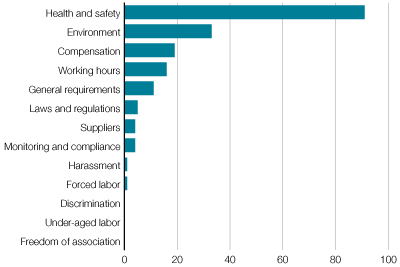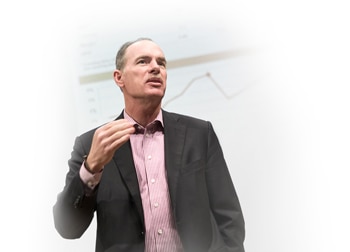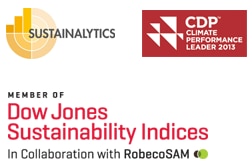Mapping and addressing human rights risks
HR4-11
Non-discrimination
Internally, all unit heads receive human rights awareness-raising information, including issues such as non-discrimination as part of the ALFA Code of Conduct assessment.
The Ethics Program also underlines the Group’s non-tolerance position on discrimination. The third wave of the program delivery is complete and currently almost 90% of all employees have access to the whistle-blower facility (Ethics Helpline), where suspected discrimination cases can be reported, alongside other ethical misconduct.
As the Ethics Program rolls out, all cases of discrimination reported via the Ethics Helpline are investigated. Corrective action on confirmed incidents of misconduct includes various ways of reinforcing greater awareness of the Group’s policy, such as retraining.
Mapping risks
Annually, Electrolux tracks areas that pose challenges to upholding high standards in human rights such as protecting freedom of association, the abolition of child labor and forced and compulsory labor. Also in 2012, Electrolux conducted a corporate human rights risk assessment to enable a better understanding of risk areas.
The Group maps its operations and those of its suppliers against geographical areas considered sensitive by external sources because of their weak legislation or poor enforcement of existing laws. Sources for these evaluations include Maplecroft.
Countries are gauged against seven elements of human rights: Civil and political rights, child labor, forced labor, discrimination, freedom of association, working conditions and corruption.
High-risk regions with Electrolux manufacturing facilities are:
- Brazil
- China
- Egypt
- Mexico
- Romania
- Thailand
- Ukraine
See also the enclosed Map: Electrolux factories worldwide.
A facility’s risk classification is adjusted depending on its past performance, taking into account additional information such as number of employees, types of activities, Ethics Helpline records and customer requests.
The scope of the internal CoC audit (see graph) is in part reflected by the outcomes of this preliminary risk assessment. The audit identifies non-compliances and corrective actions are taken as a result.
Similarly, supplier audits focus on high- and medium-risk suppliers and address non-compliance through mandatory corrective actions as well as support activities such as training.
Internal Code of Conduct Audit findings
The Global ISO certification audits, rolled out in 2013, cover issues including environmental compliance and health and safety. All manufacturing facilities are audited annually, and recertified every third year.
In addition, Electrolux conducted 20 (18) internal CoC audits by third party auditors in Brazil, China, Mexico and Thailand and follow-up audits in Argentina, Chile, Egypt and Romania. Combined teams that included Electrolux representatives completed eight of these audits. In 2014 audits will include Ukraine, China and Mexico and follow ups in Chile and Egypt.
Environment, health and safety remain the key findings in terms of number of non-compliances. Egypt, in particular, demonstrated considerable improvement in CoC compliance. Audits also underline the need to focus on CoC communication and monitoring compliance of onsite service providers. Working hours remain a challenge in some regions and the policy need to be reinforced on a continual basis.
Internal Code of Conduct audit findings

Freedom of association
In those regions where worker associations are not possible due to national praxis, each unit and its suppliers are expected to find appropriate and legal mechanisms through which workers can effectively express workplace concerns to management.
Records are to be kept from these formalized consultations and be made available upon request, as outlined in Management approach: Labor practices.
A document published in 2013 outlines the Electrolux response for information on the illegal strike that occurred at a plant in Rayong, Thailand.
Under-aged workers in the supply chain
The Group’s supplier audits reveal that issues relating to under-age labor are less prevalent than previous years. For example, zero (five) cases of under-aged workers were found in 2013. In the past, the few uncovered cases related to under-aged labor were primarily found in Asia/Pacific. The majority of age-related findings concern insufficient protection of authorized minors (16–18 years of age).
Forced and compulsory labor
The Responsible Sourcing program is designed to help ensure that the company is not complicit in any forms of abuse of forced or bonded labor in its supply chain, as outlined in Management approach: Human rights. Electrolux complies with California’s Transparency in Supply Chains Act
Indigenous rights
Electrolux does not report on indigenous rights, as these are not deemed to be among the most material issues to the company on the basis of the GRI Reporting Principles and according to Human Rights assessments conducted of its operations.
Assessment and remediation
During 2012, a corporate human rights risk assessment was conducted to identify key human rights risks and impacts. The assessment was conducted according to the UN Guiding Principles on Business and Human Rights.
This assessment is an important basis for the revision of the CoC and Workplace Standard, and thereby training, and auditing of operations in high-risk countries as reported in Management approach, Human rights, Protect, respect and remedy.
Rights-aware
Electrolux is making steady progress on its human rights agenda. In 2013 we revised our Code of Conduct and thereby strengthened our commitment to respect, protect and remedy human rights within our operations and sphere of influence.
CEO Statement

In 2013 we continued to deliver above our growth target and delivered 4.5% in organic sales growth.
CEO Statement

I'm convinced that raising product efficiency for the growing middle class is where long-term shareholder value creation lies.
Our products

Electrolux is the only appliance manufacturer in the industry to offer complete solutions for both consumers and professionals. The focus is on innovative and energy-efficient products in the premium segments.
Sustainability
Achieving the Group's vision of sustainability leadership is crucial to realizing the business strategy. The objective is to develop smarter, more accessible, resource-efficient solutions that meet people's needs and improve their lives. Read the comprehensive sustainability performance review.
Awards & recognition

Financial Reporting
Net sales for the Electrolux Group in 2013 amounted to SEK 109,151m, as against SEK 109,994m in the previous year. The organic sales growth was 4.5%, while currencies had an impact of -5.3%.
